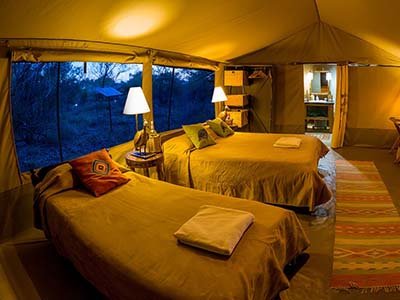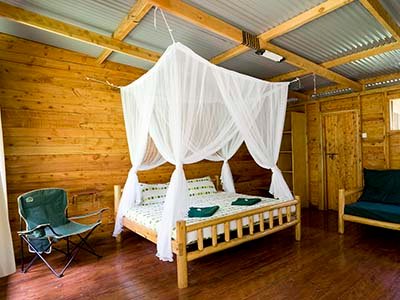Selous Game Reserve
Selous Game Reserve in Tanzania is Africa’s biggest game reserve, a wilderness region larger than either Denmark or Switzerland, at roughly 50,000 square kilometres. The Reserve is three times the size of the Serengeti and encompasses more than five percent of Tanzania’s entire geographical area. Although Selous is a little out of the way from the more well-trodden safari circuits, it is well worth the effort for the opportunity to see wildlife in a nearly untouched environment.
There are almost 200,000 buffalo, 30,000 elephants (more than half the country’s population), and 80,000 wildebeest living in the park, along with one of the most thriving groups of the critically endangered African Wild Dog. Poachers wiped off the black rhino population in the Reserve in the 1970s and 1980s, but thanks to a successful rehabilitation programme, visitors may once again see these magnificent animals in their natural habitat.
In 1905, a small portion of what is now the Reserve was designated as a game conservancy; the area was enlarged and renamed (after Frederick Courtenay Selous, a hunter and soldier from the 19th century) in the 1920s. The Selous was abandoned by humans in the 1930s and 1940s as a result of repeated outbreaks of sleeping sickness. The sleeping sickness epidemics of yesteryear are long gone, but the Selous remains a wild and uncharted region of Africa. The Reserve was declared a UNESCO World Heritage Site in 1982 because of its very unique eco-system
Because it is one of the most picturesque and game-rich regions in the ecosystem, the northern sector of Selous has been set aside for photography tourists. Wooded areas, grassy steppes, and seasonal wetlands make up around three-quarters of the Reserve. Within Selous are found several significant ecosystems, including imposing riverine forests and dense, impenetrable thickets. The Rufiji River is one of East Africa’s greatest water systems, and it’s known for its width and meandering nature. One of the most remarkable natural systems in all of East Africa, thanks to the presence of many wetlands, lakes, and swamps in the area.
Selous’s tiny and secluded camps and lodges provide walking safaris, boat safaris, and classic game drives, with little possibility of seeing any trace of human activity. Those who want to explore the finest of Africa without being confined in a safari vehicle are increasingly opting for fly camping, often known as mobile walking safaris. If you’re fortunate, you’ll see a troop of African wild dogs on your game drive or stroll.
Despite its decline elsewhere in Africa, this species is prospering in Selous. These intriguing creatures are not afraid of automobiles and may frequently be seen in close proximity, allowing us an up-close look at their vibrant social lives. The tourism zone has more dogs per square foot than any other place in Africa.
The extensive and diverse avian life of the Selous Game Reserve is a major reason for the reserve’s widespread acclaim, even though its namesake huge beasts steal the show. The most noticeable avifauna is located around the ever-shifting Rufiji River’s sandbanks, oxbow lakes, lagoons, and channels. The towering leaves of the native Borassus palms swaying in the African air add a sense of majesty to the already breathtaking riverside backdrop.
Trees as old as the baobabs, which are revered by many indigenous communities, tower over the horizon in the distance. Fish eagles perch on their dead, hollow, leafless trunks, while Egyptian geese and Dickinson’s kestrels use them as nesting places.
Wildlife and Biodiversity
The Selous Game Reserve is home to an array of wildlife and biodiversity, making it one of the most remarkable places to visit on a Tanzanian safari. The reserve boasts over 2000 species of plants, 440 bird species, and a diverse range of animals, including large mammals, predators, reptiles, and aquatic life.
The elephant and giraffe populations in Selous Game Reserve are some of the largest in the world. The reserve is one of the few remaining habitats for the African elephant, and the towering giraffe is a common sight in the woodlands and grasslands. Visitors can embark on a game drive or walking safari to observe these majestic creatures up close and personal.
Wild dogs and sable antelope are also among the resident species in Selous Game Reserve. Wild dogs, also known as painted dogs, are endangered and rare, but this reserve offers a chance to spot them. Sable antelope, with their striking black coats and curved horns, are also prevalent and make for an impressive sight.
The Nile crocodile and hippopotamus are two of the most dangerous animals in Africa, but they can be observed safely from a boat ride along the Rufiji River. These creatures make their homes in the river and surrounding swamps, and a boat safari offers the perfect opportunity to see them in their natural habitat.
Leopards are elusive creatures and can be challenging to spot in the wild, but they are present in the Selous Game Reserve, along with other predators like lions and hyenas. Night drives or walking safaris with experienced guides offer the best chances of seeing these predators in action.
Birdlife in Selous Game Reserve is also abundant, with over 440 species recorded in the area. From eagles to owls, hornbills to kingfishers, visitors can experience the sights and sounds of the vibrant birdlife in the reserve. Boat safaris along the Rufiji River offer a chance to see water birds like the African fish eagle and the saddle-billed stork.
Selous Game Reserve Management
The Selous Game Reserve is overseen by Tanzania’s Ministry of Natural Resources, which places a strong emphasis on maintaining and safeguarding the distinctive animals and natural environments present there. Initiatives for protecting wildlife are at the heart of management activities, with a focus on protecting the populations of elephant, leopard, and sable antelope in the reserve.
Hunting concessions and trophy hunting
Trophy hunting and hunting concessions are also included in the management of the Selous Game Reserve. Hunting, albeit contentious, may contribute to the management of wildlife by funding conservation initiatives and motivating regional groups to save animals. To guarantee sustainability and to protect the environment as a whole, hunting is rigorously controlled.
Sustainable tourism and lodges/camps
Selous Game Reserve has recently shifted towards sustainable tourism with a focus on developing low-impact, environmentally friendly hotels and camps. These inns and campgrounds are made to fit in with the surroundings and run in a way that has as little of an effect on the ecology as possible. The administration of Selous Game Reserve seeks to enhance the regional economy while safeguarding the reserve’s natural resources by fostering sustainable tourism.
Habitat and Ecosystem Connectivity in Selous Game Reserve
The Selous Game Reserve, a UNESCO World Heritage Site, plays a significant role in the larger Selous ecosystem as well as Tanzania’s network of national parks. The Serengeti National Park and Mikumi National Park, two neighbouring protected areas, are functionally connected to the reserve. A variety of animals, including the giraffe, wildebeest, wild dog, and the Nile crocodile, which is located in the Rufiji River, depend on this linked system for vital habitat.
In order to preserve the wellbeing of the reserve and the larger ecosystem, administration of the Selous Game Reserve is generally focused on striking a balance between the demands of wildlife conservation, hunting, and sustainable tourism. The Tanzanian Ministry of Natural Resources intends to maintain Selous Game Reserve’s status as one of East Africa’s largest and most significant protected areas by properly maintaining the reserve’s natural resources.
The Selous Game Reserve’s activities and attractions include:
In the centre of Tanzania, there lies a breathtaking location called the Selous Game Reserve. For daring tourists seeking a close encounter with African wildlife, this reserve is the ideal location. When visiting Selous Game Reserve, you should think about the following excursions and sights:
- Game Drives: A game drive is one of the greatest methods to see the animals in the Selous Game Reserve. Elephants, giraffes, lions, and other famous African wildlife may all be seen there. You will be given a tour of the reserve by knowledgeable rangers who will assist you in spotting the animals.
- Walking Safaris: A excellent way to see the reserve on foot is through walking safaris. Explore the Selous’ varied topography, which includes miombo woods, grasslands, and sand rivers. Walking safaris provide you a more personal encounter with nature and let you get near to the animals.
- Boat Safaris and Fishing: Taking a boat safari along the Rufiji River is a special opportunity to observe the reserve from a new angle. The tranquil settings allow you to see hippos and crocodiles. Another well-liked sport on the river is fishing.
- Outdoor Activities & Fly Camping: Think about fly camping in the centre of the reserve for a more daring experience. The night will be spent outside, listening to the sounds of the African forest. There are also offered outdoor activities including kayaking, bird viewing, and bush treks.
Accommodation Options
- Rufiji River Camp: This opulent tent camp is situated on the Rufiji River’s banks and provides breathtaking views of the reserve. There are 20 tents in the camp, each with a private balcony and en suite bathroom.
- The beautiful Selous Serena Camp provides a special fusion of luxury and adventure and is located in the centre of the reserve. There are 12 tents in the camp, each with its own veranda and bathroom.
- Beho Beho: This upscale resort is situated in the reserve’s northern region and provides breathtaking views of the nature surroundings. Eight roomy cabins with individual verandas and bathrooms on each floor are available at the lodge.
- Sand Rivers Selous: Situated on the Rufiji River’s banks, this opulent resort provides stunning views of the reserve. Eight open-fronted cabins with individual plunge pools and attached bathrooms make up the lodge.
- Selous Impala Camp is an eco-friendly camp that provides a rustic but opulent experience in the centre of the reserve. There are 8 tents in the camp, each with its own veranda and bathroom.





